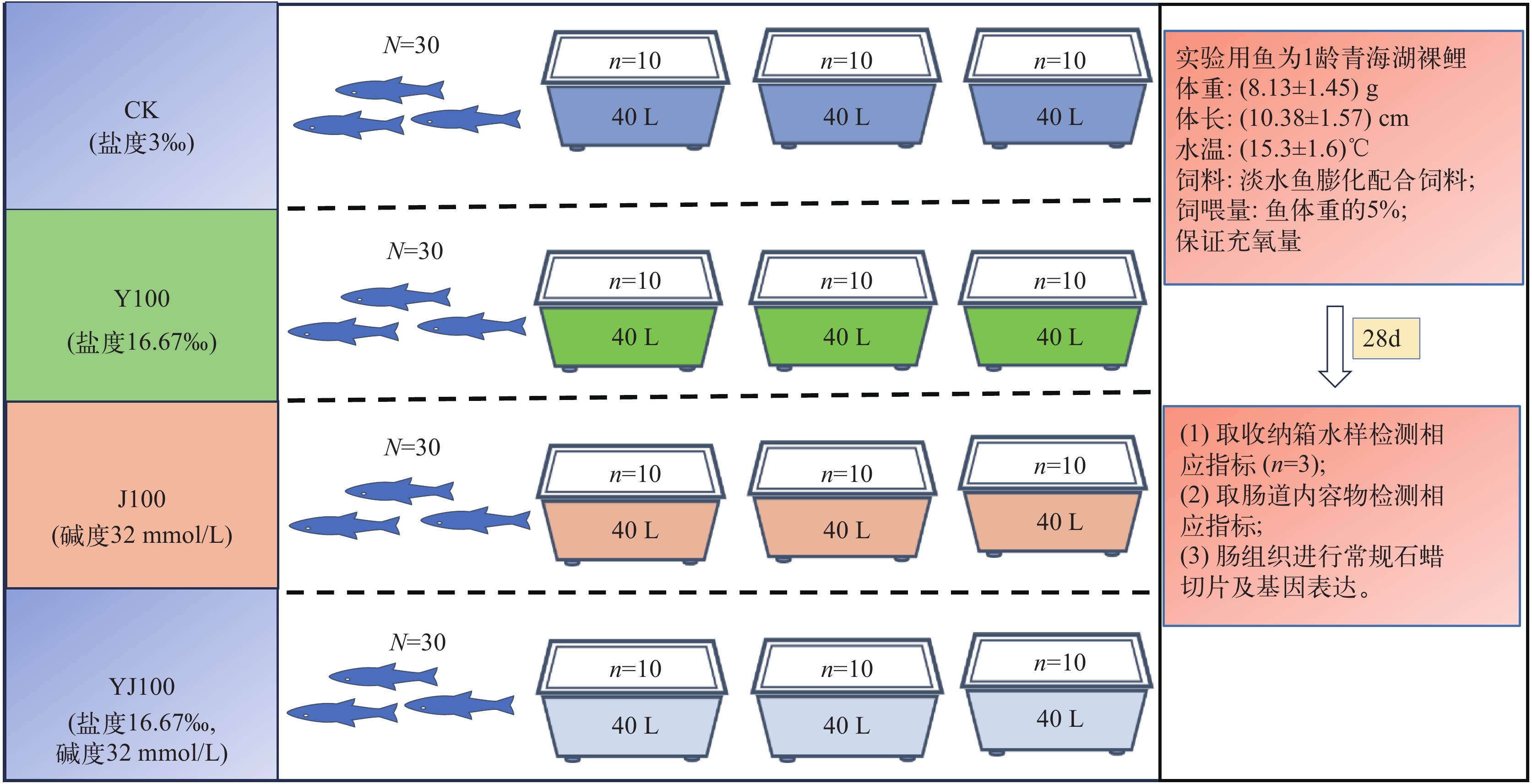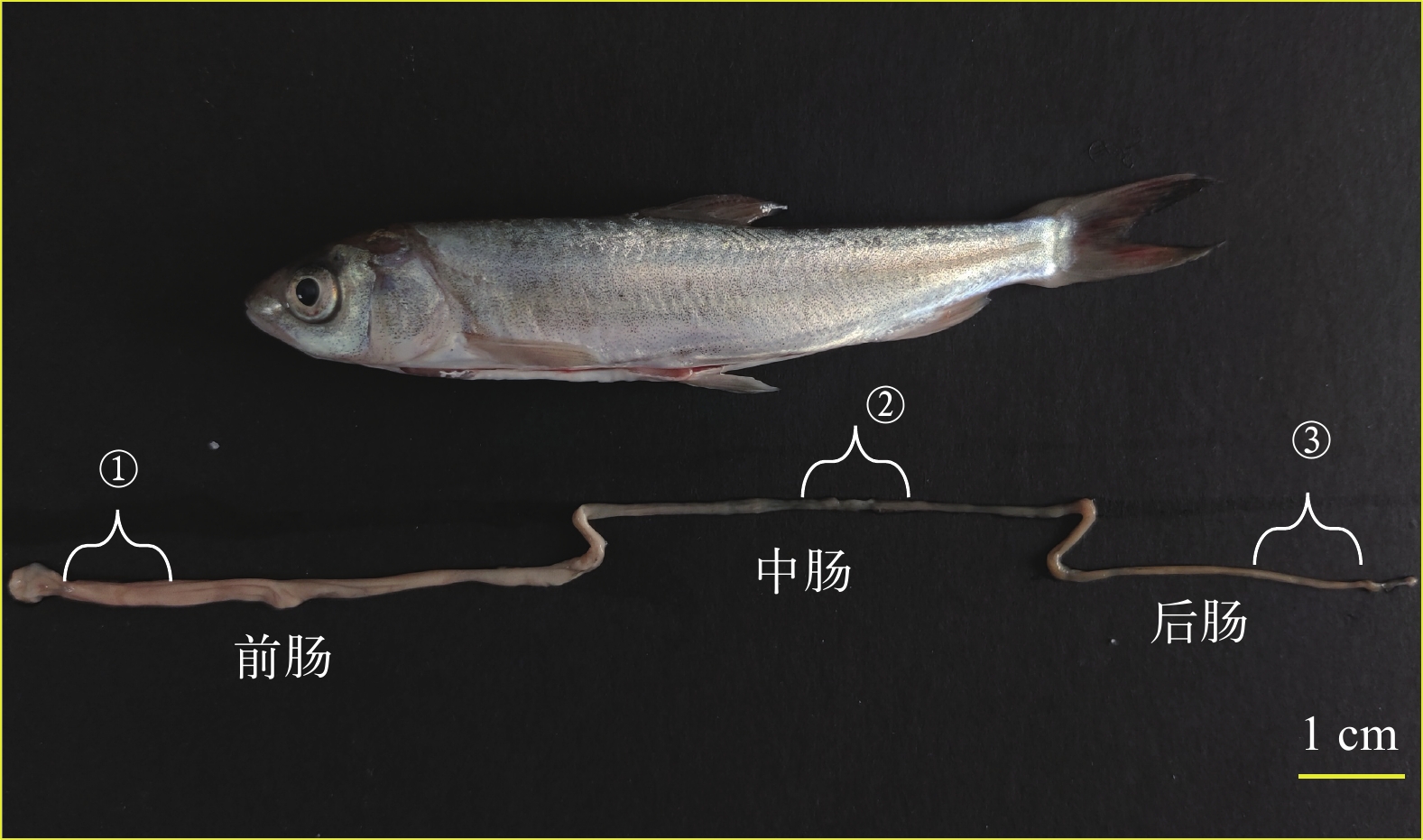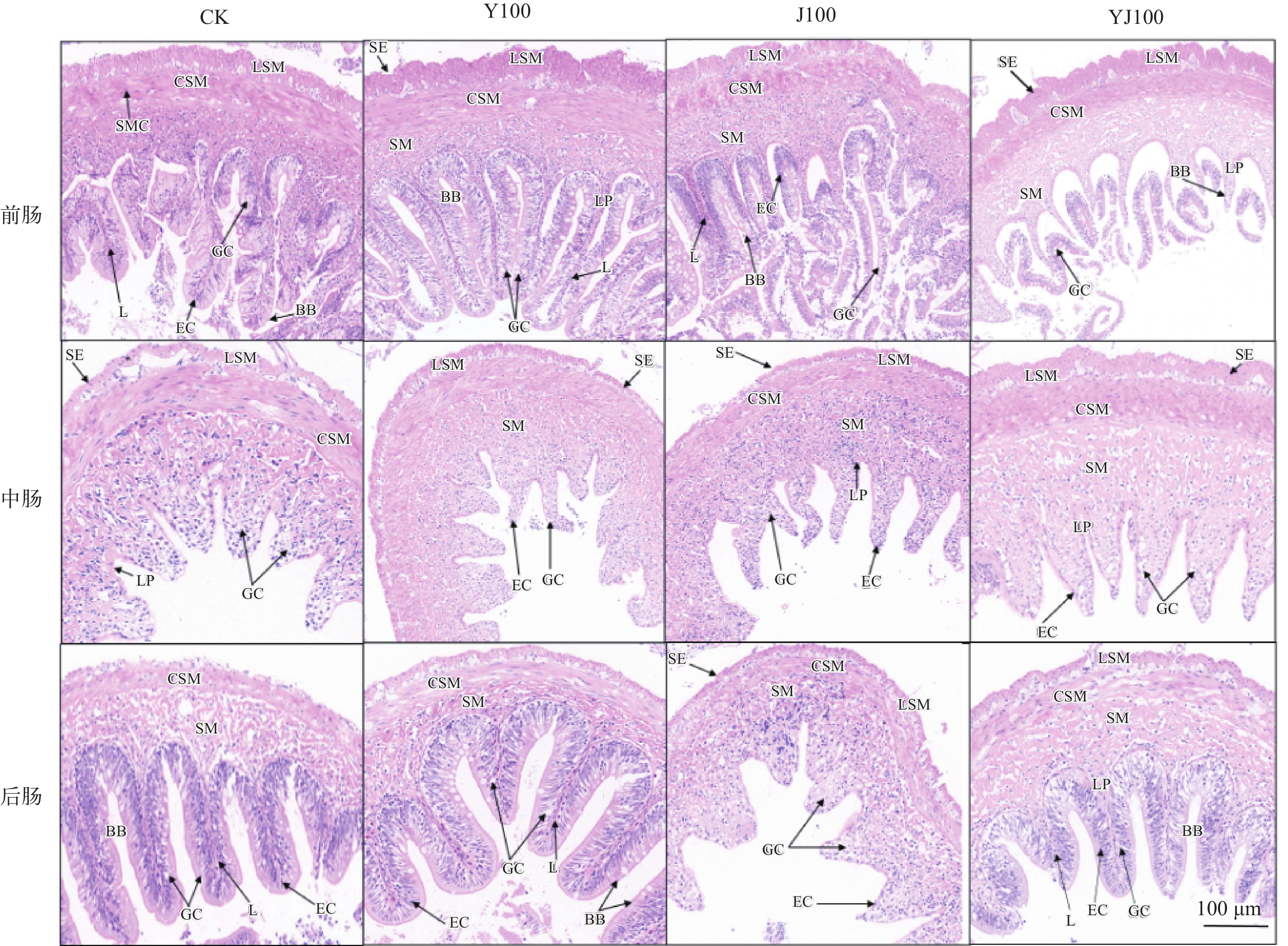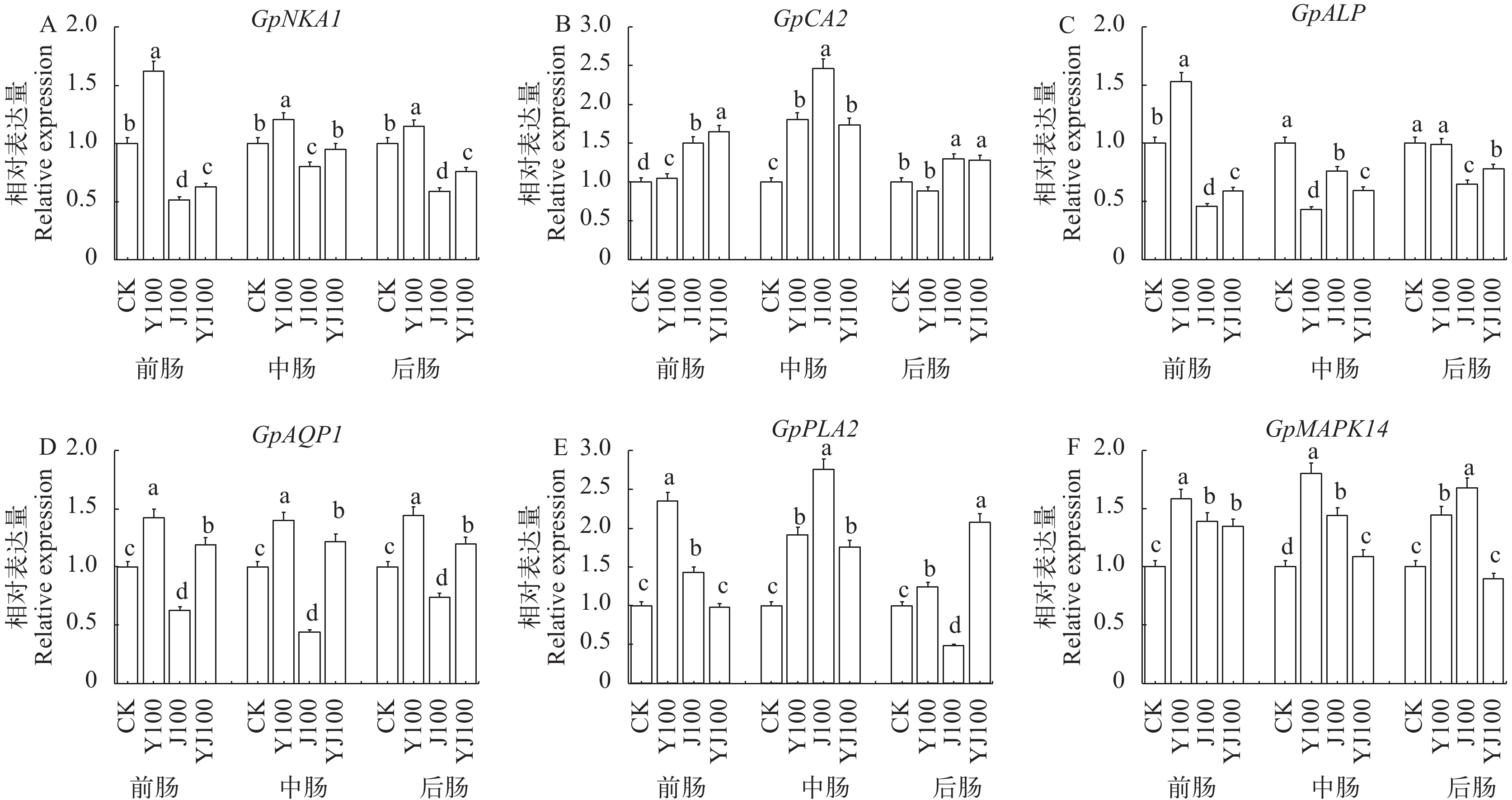SALINE AND ALKALINE STRESS ON INTESTINAL STRUCTURE AND PERMEATION-RELATED GENE EXPRESSION OF GYMNOCYPRIS PRZEWALSKII
-
摘要:
为探究盐碱胁迫对青海湖裸鲤(Gymnocypris przewalskii)肠道的影响, 将体重为(8.13±1.45) g的青海湖裸鲤一龄鱼驯养在水温为(15.3±1.6)℃的不同胁迫环境中养殖28d, 不同胁迫有盐胁迫组(Y100)、碱胁迫组(J100)和盐碱混合胁迫组(YJ100), 以3‰盐度为对照组(CK)。结果显示: J100组水环境的pH最高, CK组最低。Y100组水环境的氨氮含量最高, YJ100组最低。Y100组青海湖裸鲤的肠道结构较其他组更加完全, 浆膜层完整, 纹状缘发达; J100组和YJ100组裸鲤前肠结构受到损伤, 肌层厚度从前肠到后肠逐渐变薄; 肠道的皱褶高度方面, CK组与Y100组前肠最高, 中肠次之, 后肠最低, YJ100组则反之; J100组中肠皱褶高度最高, 后肠次之, 前肠最低。不同胁迫组渗透相关基因GpAQP1、GpMAPK14、GpPLA2和GpCA2均在中肠表达量较高, 而GpNKA1、GpALP则在前肠表达量较高。总之, 碱处理和盐碱处理损伤了青海湖裸鲤肠道结构, 从而影响了鱼体的生长发育, 这一结论为解释自然状态下青海湖裸鲤生长缓慢提供研究方向。
Abstract:To investigate the effects of saline-alkaline stress on the intestinal tract of naked carp (Gymnocypris przewalskii), first-year naked carps weighing (8.13±1.45) g were domesticated in different stress conditions at a water temperature of (15.3±1.6)℃ for 28d. The stress groups included a salinity stress group (Y100), an alkalinity stress group (J100), and a mixed saline-alkaline stress group (YJ100), with 3‰ salinity serving as the control group (CK). The results showed that the pH value was the highest in J100 group and the lowest in CK group, while the ammonia nitrogen content was the highest in Y100 group and the lowest in YJ100 group. The intestinal structure of Gymnocypris przewalskii in the Y100 group was more complete than that of the other groups, characterized by the intact plasma membrane layer and well-developed striated margin. On the contrary, the foregut of the naked carp in the J100 and YJ100 groups was damaged, with the thickness of the muscularis propria decreasing progressively from the foregut to the hindgut. In the CK and Y100 groups, the foregut showed the highest wrinkle height, followed by the midgut and the hindgut, while the opposite pattern was observed in the YJ100 group. In the J100 group, the midgut exhibited the highest wrinkle height, followed by the hindgut, with the foregut being the lowest. Furthermore, the midgut showed higher expression levels of osmosis-related genes, including GpAQP1, GpMAPK14, GpPLA2, and GpCA2 under different stress conditions, whereas the foregut exhibited high expression of GpNKA1 and GpALP. In conclusion, saline and alkaline treatments caused damage to the intestinal structure of Gymnocypris przewalskii, thus affecting the growth and development of the fish. This finding provides insights into the slow growth observed in Gymnocypris przewalskii exposed to saline-alkaline stress in natural habitats.
-
青海湖裸鲤(Gymnocypris przewalskii)是青海湖特有的一种生殖洄游鱼类[1], 其具有应对寒冷、低氧、高盐碱湖水生存环境的独特适应能力[2], 故因其耐高寒、耐低氧、耐盐碱等优良特性而备受关注[3]。为适应水环境盐度、碱度、离子组成及pH的变化, 鱼类拥有较强的离子和渗透压调节机制[4], 青海湖裸鲤的盐碱耐受能力很强[1]。
鱼类的渗透平衡是通过肠、肾和鳃上皮协调调节水和离子运输来维持的[5]。目前, 有关鱼类鳃和肾在渗透和酸碱调节方面的作用已有较为深入的研究[6, 7], 有研究发现肠道在维持渗透和酸碱平衡中也发挥着重要作用[8—10]。淡水鱼类肠道可以从食物和水中吸收大量的离子以补充体内离子的流失。海水鱼类的肠道则是非常重要的水分吸收场所, 吸收的水分用于补充体内水分流失。海水鱼类必须饮入大量的海水用于补充体内水分的流失, 饮入的海水在食管、胃、肠道中逐步脱盐, 降低肠液渗透压, 使肠液渗透压低于体液渗透压, 从而有利于水分吸收。鱼类与其他脊椎动物一样, 肠道结构分为若干部分, 但不同鱼类消化系统存在差异, 可以分为有胃鱼类和无胃鱼类, 有胃鱼类肠前端与胃的幽门部相连, 无胃鱼类的肠道直接与食道相连, 肠后端止于肛门[11]。鱼类肠道长度会随着年龄变化而改变或随着摄食物种和摄入量的改变发生变化[12]。
鱼类肠道的组织学结构一般分为黏膜层、黏膜下层、肌层和浆膜层四层。黏膜层在肠道内侧, 由上皮和腺体组成, 能吸收营养物质, 并可分泌黏液。黏膜层向上突起形成褶皱, 在空腹时褶皱变深, 摄食后腹腔内食物充足时黏膜层舒展开, 褶皱随之变浅, 充以足够量的食物时消失。黏膜下层包含丰富的血管及淋巴管, 能滋养上皮及腺体。肌层由环肌和纵肌两层平滑肌构成, 肌肉的收缩和舒张会使肠道蠕动, 加速食物的消化吸收及食物残渣的排出[13]。浆膜层由疏松结缔组织构成, 主要作用是联系和支持肠道结构[14]。本研究探究了青海湖裸鲤在盐碱胁迫下的肠道结构变化, 分析了水环境、肠道内容物及渗透相关基因的表达, 为解释盐碱水养殖鱼类肠道健康与生长之间的关系奠定了一定基础, 同时也为青海湖裸鲤肠道发挥渗透调节作用提供参考。
1. 材料与方法
1.1 材料
实验用鱼由青海湖裸鲤救护中心(西宁, 中国)提供。实验开始前青海湖裸鲤在实验室驯化饲养 14d, 驯化用水为海水晶盐处理后的自来水(盐度为 3‰), 每天换水1次并保持充氧, 喂食1次。饲料为四川斯特佳饲料有限公司生产的淡水鱼膨化配合饲料(表 1)。
表 1 饲料主成分Table 1. Main components of feed成分Ingredient 进口鱼粉 粗蛋白质 ≥ 60% 小麦粉 粗脂肪 ≥ 15% 鱼油 粗纤维 ≤ 3% 免疫增强剂 钙 ≤ 12% 矿物质混合物 总磷 ≥ 0.8% 维生素混合物 氨基酸 ≥ 3.3% 试验用盐为青岛海科通用海水素有限公司生产的海量星海水素, 碱为无水碳酸钠(国药集团化学试剂有限公司)和碳酸氢钠(上海广诺化学科技有限公司)共同配制, 胁迫试验浓度设置如表 2。
表 2 浓度配制Table 2. Concentration formulation浓度
Concentration (%)40L-NaHCO3
用量40L-
Dosage of NaHCO3 (g)40L-Na2CO3
用量40L-
Dosage of Na2CO3 (g)40L-海水晶
用量40L-
Dosage of Sea
crystal salt (g)CK 0 0 1.999 Y100 0 0 666.667 J100 92.594 10.368 0 YJ100 92.594 10.368 666.667 1.2 方法
盐碱胁迫实验 在驯化后进行胁迫实验, 在青海大学冷水鱼循环车间进行。共设 4 组, 分别为 CK 组(对照组, 盐度 3‰)、 Y100 组(盐胁迫组, 盐度 16.67‰)、 J100 组(碱胁迫组, 碱度 32 mmol/L)、YJ100 组(盐碱混合胁迫组, 盐度 16.67‰, 碱度 32 mmol/L), 3个胁迫组从CK组养殖环境直接转入胁迫组养殖环境, 每组 3 个重复, 胁迫组用海水晶盐、Na2CO3 和 NaHCO3配制(NaHCO3﹕Na2CO3=9﹕1), 盐碱浓度配料见表 2[15]。实验期间, 每日定时投喂两次饲料(实验开始前一天停止喂食), 每2天换2/3水量并保证充氧量, 胁迫时间为28d (图 1)。
样品采集 在胁迫处理期间, 取各实验组水样测 pH、溶氧度(DO)、氨氮和硝氮。胁迫结束后每组采3 尾鱼肠组织用于组织切片, 采6 尾鱼测定肠道内容物的 pH和 DO。参考金建丽等[16]的方法, 将肠道分为前肠、中肠和后肠(图 2), 参考 Bergman等[17]的方法, 测定 pH和溶氧度; 最后将前、中、后肠组织在 4%多聚甲醛固定 24h后, 转移至 70%乙醇于 4℃冰箱保存, 后续进行常规石蜡切片。
总RNA提取及反转录 TRIzol 法提取组织总 RNA, 使用 cDNA 合成(TaKaRa, 6210A)试剂盒将组织总 RNA 反转录成 cDNA 模板。利用 RNA 浓度检测仪和凝胶电泳检测 RNA 质量和浓度。检测合格的 RNA 用来进行 cDNA 合成, 合成产物稀释后放入–80℃冰箱保存备用。
荧光引物设计与验证 根据青海湖裸鲤转录组数据[18]获得渗透及代谢相关重要基因Na+/K+-ATP 酶(Na+-K+-ATPase-1a, GpNKA1)、水通道蛋白(Aquaporin1, GpAQP1)、碱性磷酸酶(Alkaline phosphatase, GpALP)、碳酸酐酶(Carbonic anhydrase2, GpCA2)、丝裂原活化蛋白激酶(Mitogen-activated protein kinase14, GpMAPK14)、磷脂酶A2 (PhospholipaseA2, GpPLA2), 使用Oligo 7.0 设计荧光引物, 之后进行引物验证, 确保引物特异性。引物的合成及 PCR产物测序均在生工生物工程(上海)有限公司进行。经验证选出具有特异性的引物(表 3), 进行实时荧光定量 PCR。
表 3 荧光定量PCR引物Table 3. Fluorescent quantitative PCR primers名称Name 引物序列Primer sequence (5′—3′) NKA1-F CTTGAAGTTGGTCGCACTC NKA1-R AGTTCTTCTTTGCCATACGTT CA2-F TCTGGATTACTGGACGTACC CA2-R TTGAAAGATGCACGGACCT ALP-F GCGAGTAAACCATGCCACT ALP-R CATCTTTGCGTGTACCGTTG AQP1-F GGGCTAAATACAATCAGTGCTA AQP1-R ATTGATCCCACATCCCGT PLA2-F GCGAGTAAACCATGCCACT PLA2-R CATCTTTGCGTGTACCGTTG MAPK14-F CTGTAAGTCGCATTATCTGTTG MAPK14-R CTGTAAGTCGCATTATCTGTTG EF1α-F GTATTACCATTGACATTGC EF1α-R CTGAGAAGTACCAGTGAT 实时荧光定量PCR 通过qRT-PCR检测基因在对照组(CK)、盐胁迫组(Y100)、碱胁迫组(J100)、盐碱胁迫组(YJ100)中青海湖裸鲤前肠、中肠、后肠的表达情况, 按照TB GreenTM Premix Ex TaqTM Ⅱ (Tli RNaseH Plus)操作步骤配置 20 μL 反应体系, EF-1α 为内参基因。荧光 PCR 程序包括: 95℃, 30s; 95℃, 5s; 55℃, 30s; 72℃, 30s; 12℃, ∞; 进行 40 个循环, 每个样品设置 3 个重复。
1.3 数据处理
实验数据以平均值±标准差表示, 采用SPSS 13.0软件进行单因素方差分析(One-way ANOVA)。用 Duncan法进行组内多重比较分析, 用t检验比较分析组间差异。P<0.05 具有显著差异。使用Excel进行统计分析, 随后采用Origin作图。
2. 结果
2.1 不同水环境下基础指标检测
如表 4所示, 碱胁迫组水环境pH最高, 显著高于其他组(P<0.05); CK组水环境pH最低(P<0.05)。四种处理下水环境溶氧度无显著差异。氨氮在盐胁迫组最高(P<0.05), 盐碱胁迫组最低(P<0.05)。硝氮含量碱胁迫组最高, 显著高于其他处理组(P<0.05)。增重率盐胁迫组最高, 对照组次之, 碱胁迫组最低。死亡率碱胁迫组最高, 盐碱胁迫组次之, 盐胁迫组最低。
表 4 不同胁迫下基础指标检测Table 4. Detection of basic indicators under different stresses组别
Group指标Index 水体pH 水体溶氧度
Dissolved oxygen
(mg/L)水体氨氮
Ammonia nitrogen
content (mg/L)水体硝氮
Nitrate-nitrogen
content (mg/L)增重率
Weight gain
rate (%)死亡率
Mortality
(%)CK 6.16±0.06d 6.94±0.21 3.71±0.08b 0.83±0.05b 1.73±0.13b 20.00±5.00c Y100 7.36±0.04c 6.78±0.22 4.32±0.02a 0.79±0.09b 1.91±0.09a 16.67±7.64c J100 9.12±0.12a 6.98±0.03 2.18±0.24c 4.27±0.03a 1.43±0.18c 56.67±2.89a YJ100 8.54±0.05b 7.04±0.17 0.12±0.03d 0.99±0.11b 1.52±0.16c 43.33±7.64b 注: 同列数据不同上标字母表示组内差异显著(P<0.05); 下同Note: Different superscript letters in the same column indicate significant differences (P<0.05); the same applies below 2.2 盐碱胁迫对青海湖裸鲤肠道内容物pH、溶氧度的影响
前肠内容物pH在盐碱胁迫组最高, 盐胁迫组最低; 中肠内容物pH在碱胁迫组最高, 对照组最低; 后肠内容物pH在碱胁迫组显著高于其他处理组(P<0.05), 对照组最低。前肠内容物溶氧度在对照组最高, 且显著高于其他3组, 盐碱胁迫组最低; 中肠内容物溶氧度对照组最高, 盐碱胁迫组最低; 后肠内容物溶氧度对照组最高, 碱胁迫组最低(表 5)。
表 5 盐碱胁迫对青海湖裸鲤肠道内容物pH、溶氧度的影响Table 5. Effects of saline-alkaline stress on intestinal contents pH and dissolved oxygen of G. przewalskii组别Group 肠道内容物检测指标Indicators of intestinal contents 前肠pH
The pH of the
foregut中肠pH
The pH of the
midgut后肠pH
The pH of the
hindgut前肠溶氧度
Foregut dissolved
oxygen (mg/L)中肠溶氧度
Midgut dissolved
oxygen (mg/L)后肠溶氧度
Hindgut dissolved
oxygen (mg/L)CK 6.40±0.36 6.52±0.22 6.19±0.25c 7.44±0.32a 7.28±0.24a 7.18±0.36a Y100 6.36±0.06 6.54±0.09 6.26±0.28c 6.82±0.22b 6.68±0.16b 6.76±0.15b J100 6.52±0.33 6.63±0.23 7.06±0.12a 6.42±0.09c 6.34±0.05c 6.28±0.18c YJ100 6.49±0.26 6.54±0.04 6.62±0.29b 6.36±0.23d 6.28±0.07c 6.30±0.06c 2.3 盐碱胁迫对青海湖裸鲤肠显微结构的影响
组织切片显示, 青海湖裸鲤肠道由内至外分别由黏膜层、黏膜下层、肌肉层和浆膜层组成, 肌肉层包括环肌和纵肌, 杯状细胞可见。盐胁迫组肠道结构较对照组而言, 结构更加完整, 浆膜层较完整。对照组与盐胁迫组均是前肠和后肠部分的纹状缘比中肠清晰完整, 碱胁迫组前肠部分纹状缘清晰但不完整, 盐碱胁迫组后肠纹状缘分布较清晰完整。碱胁迫和盐碱胁迫在一定程度上损伤了青海湖裸鲤前肠结构, 其纹状缘无规律分布, 杯状细胞减少, 中肠与后肠部位损伤程度较弱。此外, 青海湖裸鲤肠道前、后部组织结构基本相同, 中肠部位与前后肠相比略有差异, 其中前中后三段肠道部位黏膜褶皱高度、环肌和纵肌厚度也有差异, 杯状细胞数量前肠与后肠分布较多, 而中肠较少, 且碱胁迫组与盐碱胁迫组杯状细胞相较于对照组与盐胁迫组有所增加, 尤其是肠道后部增加较为明显, 淋巴细胞在对照组和盐胁迫组前肠、后肠及盐碱胁迫组后肠中排列规律且数量较多, 碱胁迫组淋巴细胞前、中、后肠数量均偏少。上皮细胞在对照组与盐胁迫组前肠和后肠、盐碱胁迫组后肠有规律地分布于杯状细胞周围, 而在碱胁迫组整体分布杂乱无序(图 3)。
![]() 图 3 不同胁迫下青海湖裸鲤肠道显微结构观察LP. 固有膜; BB. 纹状缘; GC. 杯状细胞; SE. 浆膜; LSM. 纵肌; CSM. 环肌; SM. 黏膜下层; L. 淋巴细胞; EC. 上皮细胞Figure 3. Intestinal microstructure of G. przewalskii under different stressesLP. lamina propria; BB. striate border; GC. goblet cell; SE. serosa; LSM. longitudinal muscle; CSM. circular muscle; SM. submucosa; L. lymphocyte; EC. epithelial cell
图 3 不同胁迫下青海湖裸鲤肠道显微结构观察LP. 固有膜; BB. 纹状缘; GC. 杯状细胞; SE. 浆膜; LSM. 纵肌; CSM. 环肌; SM. 黏膜下层; L. 淋巴细胞; EC. 上皮细胞Figure 3. Intestinal microstructure of G. przewalskii under different stressesLP. lamina propria; BB. striate border; GC. goblet cell; SE. serosa; LSM. longitudinal muscle; CSM. circular muscle; SM. submucosa; L. lymphocyte; EC. epithelial cell青海湖裸鲤肠道显微结构观察发现, 从前肠到后肠肌层厚度逐渐变薄, 且前肠均显著高于中肠和后肠(P<0.05)。皱褶高度在对照组和盐胁迫组是前肠最高, 中肠最低, 碱胁迫组在前肠最高, 后肠最低, 盐碱胁迫组在后肠最高, 前肠最低(表 6)。
表 6 青海湖裸鲤肠道基本结构部分测量指标Table 6. Some measured indices of basic structure of intestine in G. przewalskii测量指标
Index测量部位
Measured sectio组别Group CK Y100 J100 YJ100 皱褶高度
Fold height (μm)前肠 201.74±
21.45a249.26±
12.25a95.32±
13.7573.07±
0.84b中肠 86.18±
14.95c72.16±
14.99b88.72±
10.53106.35±
1.33a后肠 105.26±
16.32b80.23±
12.98b74.43±
0.86113.25±
3.26a肌层厚度
Muscularis thickness (μm)前肠 87.56±
2.20a106.61±
2.33a113.71±
1.36a105.53±
1.82a中肠 53.23±
3.60b89.52±
1.56b76.76±
2.52b99.08±
3.09b后肠 34.08±
2.56c64.81±
0.06c33.18±
2.78c72.73±
2.13c2.4 盐碱胁迫下渗透及代谢相关基因在青海湖裸鲤不同肠道部位的表达分析
通过对盐碱胁迫下青海湖裸鲤渗透相关基因在肠道不同部分的表达分析发现, GpNKA1在碱胁迫组和盐碱胁迫组肠道中表达均受到抑制, 在盐胁迫组表达量均高于对照组, 且盐胁迫组前肠中表达最高(图 4A); GpCA2 除在盐胁迫组后肠表达量低于对照组, 其余均高于对照组, 且在碱胁迫组的中肠表达量最高(图 4B); GpALP在盐胁迫组前肠表达量高于对照组, 其余组表达量均低于对照组(图 4C); GpAQP1在碱胁迫组表达量均低于对照组, 盐胁迫组后肠最高(图 4D); GpPLA2除盐碱胁迫组前肠和碱胁迫组后肠表达量低于对照组外, 其余组表达量均高于对照组, 且在盐胁迫组中肠表达量最高(图 4E); GpMAPK14除盐碱胁迫组后肠部位的表达量低于对照组, 其余组表达量均高于对照组(图 4F)。
3. 讨论
3.1 盐碱胁迫对水环境及青海湖裸鲤肠道内容物的影响
本实验养殖水环境pH从高到低的顺序为J100>YJ100>Y100>CK, 且胁迫实验进行期间, 碱胁迫组鱼死亡率明显高于其他组鱼类, 说明碱度与酸碱度之间可能有一定的交互关系, 雷衍之等[19]也得出同样结论。在一定条件下, 总碱度越高致死作用越大, 而在总碱度一致的水中则是pH越高对鱼的致死作用越大。氨和尿素的排泄量是氮平衡和蛋白质代谢重要指标[20], 而鱼类氮排泄受pH[21, 22]、盐度[23]、碱度[24, 25]等多种因素的影响, 其中盐度和碱度是影响氮排泄的主要因素。青海湖裸鲤以氨排泄为主, 碱胁迫组与盐碱胁迫组水环境的氨氮浓度低于对照组, 而盐胁迫组氨氮含量高于对照组, 说明盐胁迫下促进青海湖裸鲤生长进而排泄量增加, 碱环境可能会抑制其氨排泄, 衣晓飞等[23]在研究高碱环境下青海湖裸鲤氮废物排泄中也得出类似结论。盐度是影响鱼类生长的重要环境因素, 当受到盐胁迫时, 鱼类需消耗大量能量来维持体内渗透压平衡, 当盐度超过耐受范围时, 鱼类组织器官会受到损伤, 从而影响鱼类的存活和生长[26]。而在本研究中, 相较于对照组、碱胁迫组与盐碱胁迫组而言, 盐胁迫组鱼类生长状态较好, 死亡率最低, 且盐胁迫组中水环境的氨氮浓度甚至高于对照组, 说明盐度胁迫促进青海湖裸鲤的排泄, 由此推测适量的盐度对青海湖裸鲤的生存有一定的积极作用。
青海湖裸鲤进入高盐碱环境后, 与淡水环境中游动行为差异较大, 出现窜游加急、惊跳、贴壁上窜现象, 这是其对外界环境压力做出的应激反应, 与大部分鱼类高盐碱胁迫下的应激反应相似[27, 28]。硝氮被认定为一种潜在水质毒理因子, 它可能通过鳃或肠道或等组织被动扩散或吸收进入鱼体, 并可直接作用或转化为其他物质间接作用于机体, 干扰其正常的生理或内分泌活动, 最终造成鱼体稳态失调[29]。在本研究中, 水环境硝氮含量由高到低依次为碱胁迫组、盐碱胁迫组、对照组、盐胁迫组, 而青海湖裸鲤在碱胁迫组死亡率最高, 盐胁迫组存活率较高, 这可能是由于碱胁迫组水体中硝氮的毒理性作用导致了青海湖裸鲤死亡。pH在碱胁迫组与盐碱胁迫组中, 从前肠到后肠pH逐渐升高, 且远低于水环境pH (8.53—9.24), 这与马加迪罗非鱼[17]趋势一致。此外, pH在碱胁迫组后肠显著偏高, 这可能是由于青海湖裸鲤在高盐碱环境下肠道结构受到损伤, 进而影响了肠道生理功能, 导致部分碱水在后肠积累。
3.2 盐碱胁迫对青海湖裸鲤肠道显微结构的影响
肠道能有效吸收液体弥补高渗环境造成的脱水, 也是海水鱼类渗透压调节的重要器官[30]。本研究涉及的盐碱胁迫实验, 其水体相对于淡水环境来说, 属于高渗环境。王萍等[31]发现在盐碱环境下青海湖裸鲤通过肠道Cl–/${\mathrm{HCO}}^-_3 $交换子、Na+-${\mathrm{HCO}}^-_3 $联合转运子分泌和排泄机体内积累的碱, 有助于补偿因水环境中盐碱度升高而造成的渗透及酸碱失衡。Wood等[32]在裸鲤的前肠部分收集到液体, 并发现其肠内的 Mg2+ 和 Ca2+ 浓度均高于血浆含量, 认为青海湖裸鲤与海水鱼类的肠道离子吸收机制相似。此外, 王萍等[31]在室内碱度短期胁迫实验中发现, 湖水组直肠排泄物的${\mathrm{HCO}}^-_3 $浓度最高, 支持青海湖裸鲤肠道在其渗透压调节中发挥重要作用。本研究HE染色处理下青海湖裸鲤的肠道结构组织, 与其他大多数鱼类相似, 由内向外依次由黏膜层、黏膜下层、肌层和浆膜层构成, 前、中和后肠肠道结构基本相似, 肠壁和肌层可以提供更多的肠道蠕动力, 促进消化和剩余食团向后继续的运送, 盐胁迫组肠道结构较对照组而言结构更加完整, 说明青海湖裸鲤能够很好的适应高盐环境。碱胁迫和盐碱胁迫在一定程度上损伤了青海湖裸鲤肠道结构, 但碱胁迫下肠道损伤程度高于盐碱胁迫组, 这说明盐能够缓解碱胁迫对肠道造成的损伤。杂食性鱼类前肠容量不大, 但黏膜皱褶高且密, 极大地增加了前肠的消化功能[33], 本研究中青海湖裸鲤前肠皱褶高度较高, 也进一步说明青海湖裸鲤主要依靠前肠吸收营养物质。陈付菊等[34]的研究表示青海湖裸鲤的前肠是消化和吸收的主要功能部位。此外, 本研究中发现青海湖裸鲤肠道前、后部组织结构基本相同, 中肠部位与前后肠相比略有差异, 其中前中后三段肠道部位黏膜褶皱高度、环肌和纵肌厚度也有差异, 与蔡伟杰等[35]对青海湖裸鲤肠道显微结构研究结果一致。肠道具有免疫功能, 具有物理屏障、生物屏障、免疫屏障等, 是体内最大最复杂的免疫器官[36]。肠道上皮细胞通过细胞间紧密连接将肠腔中的微生物及其产生的有害物质与肠壁深部的无菌组织隔离开[37]。本研究中对照组与盐胁迫组前肠和后肠及盐碱胁迫组后肠上皮细胞有规律地分布于杯状细胞周围, 而碱胁迫组上皮细胞整体分布较杂乱, 碱胁迫损伤了肠道结构及细胞排列, 从而导致相关生理功能受到影响, 进而限制了青海湖裸鲤的生长及生存。纹状缘为发达的微绒毛, 可进一步加大吸收面积[38]。本研究对照组与盐胁迫组前肠和后肠纹状缘较发达, 而碱胁迫组与盐碱胁迫组纹状缘不完整且分布不清晰, 由此推测青海湖裸鲤依靠前肠和后肠进行营养物质吸收, 盐碱胁迫损坏肠道纹状缘结构, 减少了吸收面积, 进而影响了青海湖裸鲤生长。杯状细胞具有润滑、吸收和转运大分子、辅酶因子, 抵御外来致病因子等作用, 是肠道屏障的重要组成部分[39]。整体看来青海湖裸鲤杯状细胞数量前肠与后肠分布较多, 而中肠较少, 在碱胁迫组和盐碱胁迫组中分布较多, 尤其是后肠部位, 说明青海湖裸鲤主要通过前肠和后肠分泌黏液, 形成一层屏障从而阻碍细菌与肠上皮结合。在盐碱胁迫下肠道可能需要分泌更多的黏液来增加对黏膜的保护、抵抗外界压力, 防止有害菌群的入侵, 从而减缓盐碱胁迫对自身造成的损伤, 进而维持体内稳态。
3.3 盐碱胁迫对肠道渗透相关基因表达的影响
盐碱水域是内陆水域的一种特殊类型, 不仅盐度高、离子复杂, 同时具有高碱、高pH等特点, 不利于鱼类等水生生物生存[40]。硬骨鱼类肠道在鱼类适应高盐度环境时, 可从吞入的海水中吸收水分, 从而弥补渗透失水, 因此是鱼类渗透压调节的重要器官。为适应不同的水环境条件, 广盐性硬骨鱼类可通过调动高效的离子/渗透调节机能, 维持体液中水分和盐类的平衡, 保持稳定的渗透压。其中, NKA和CA是直接参与离子转运的主要转运酶[41]。在盐碱胁迫下尼罗罗非鱼鳃中NKA基因表达量变化程度与其盐碱胁迫浓度间呈正相关[42], CA在鱼类适应碱性环境中发挥重要作用, 参与胞内CO2水合过程的可逆催化反应, 帮助维持酸碱平衡和离子转运[43]。在本研究中, GpNKA1在盐胁迫组前肠表达最高, 盐碱胁迫组中肠表达量最高, GpCA2在各胁迫组中均是中肠表达量最高, 表明在盐碱胁迫下青海湖裸鲤中肠在离子转运和酸碱平衡起重要作用。AQP1主要在肠道中表达, 且海水鳗鱼肠道中AQP1 mRNA的表达水平高于淡水鳗[44]。在本研究中, GpAQP1在盐胁迫、盐碱胁迫下前肠和后肠表达均高于对照组, 表明GpAQP1在肠道中主要响应盐胁迫。ALP在机体内分布广泛, 在消化道中主要参与脂质、葡萄糖和无机磷酸盐等营养物质的消化吸收[45], 通常被认为是消化道吸收营养物质的标志酶, 在消化道中主要分布在前肠和中肠。鳜[46]、胡子鲇[47]、奥尼罗非鱼[48]等主要通过前肠吸收营养物质, 本研究中GpALP盐胁迫组前肠表达量最高, 碱胁迫组中肠表达量最高, 盐碱胁迫组后肠表达量最高, 可能是由于盐碱胁迫影响了青海湖裸鲤肠道结构, 进而影响了肠道消化吸收。
4. 结论
本研究表明, 青海湖裸鲤具有很强的高盐度耐受性, 在盐胁迫下生长良好, 而碱胁迫和盐碱胁迫会影响裸鲤肠道结构发育以及鱼体消化吸收, 进一步影响生长发育; 此外, 青海湖裸鲤肠道也可参与渗透调节, 以此维持鱼体稳态。本研究丰富了鱼类肠道的基础研究, 为青海湖裸鲤的盐碱适应性研究提供了思路。
-
图 3 不同胁迫下青海湖裸鲤肠道显微结构观察
LP. 固有膜; BB. 纹状缘; GC. 杯状细胞; SE. 浆膜; LSM. 纵肌; CSM. 环肌; SM. 黏膜下层; L. 淋巴细胞; EC. 上皮细胞
Figure 3. Intestinal microstructure of G. przewalskii under different stresses
LP. lamina propria; BB. striate border; GC. goblet cell; SE. serosa; LSM. longitudinal muscle; CSM. circular muscle; SM. submucosa; L. lymphocyte; EC. epithelial cell
表 1 饲料主成分
Table 1 Main components of feed
成分Ingredient 进口鱼粉 粗蛋白质 ≥ 60% 小麦粉 粗脂肪 ≥ 15% 鱼油 粗纤维 ≤ 3% 免疫增强剂 钙 ≤ 12% 矿物质混合物 总磷 ≥ 0.8% 维生素混合物 氨基酸 ≥ 3.3% 表 2 浓度配制
Table 2 Concentration formulation
浓度
Concentration (%)40L-NaHCO3
用量40L-
Dosage of NaHCO3 (g)40L-Na2CO3
用量40L-
Dosage of Na2CO3 (g)40L-海水晶
用量40L-
Dosage of Sea
crystal salt (g)CK 0 0 1.999 Y100 0 0 666.667 J100 92.594 10.368 0 YJ100 92.594 10.368 666.667 表 3 荧光定量PCR引物
Table 3 Fluorescent quantitative PCR primers
名称Name 引物序列Primer sequence (5′—3′) NKA1-F CTTGAAGTTGGTCGCACTC NKA1-R AGTTCTTCTTTGCCATACGTT CA2-F TCTGGATTACTGGACGTACC CA2-R TTGAAAGATGCACGGACCT ALP-F GCGAGTAAACCATGCCACT ALP-R CATCTTTGCGTGTACCGTTG AQP1-F GGGCTAAATACAATCAGTGCTA AQP1-R ATTGATCCCACATCCCGT PLA2-F GCGAGTAAACCATGCCACT PLA2-R CATCTTTGCGTGTACCGTTG MAPK14-F CTGTAAGTCGCATTATCTGTTG MAPK14-R CTGTAAGTCGCATTATCTGTTG EF1α-F GTATTACCATTGACATTGC EF1α-R CTGAGAAGTACCAGTGAT 表 4 不同胁迫下基础指标检测
Table 4 Detection of basic indicators under different stresses
组别
Group指标Index 水体pH 水体溶氧度
Dissolved oxygen
(mg/L)水体氨氮
Ammonia nitrogen
content (mg/L)水体硝氮
Nitrate-nitrogen
content (mg/L)增重率
Weight gain
rate (%)死亡率
Mortality
(%)CK 6.16±0.06d 6.94±0.21 3.71±0.08b 0.83±0.05b 1.73±0.13b 20.00±5.00c Y100 7.36±0.04c 6.78±0.22 4.32±0.02a 0.79±0.09b 1.91±0.09a 16.67±7.64c J100 9.12±0.12a 6.98±0.03 2.18±0.24c 4.27±0.03a 1.43±0.18c 56.67±2.89a YJ100 8.54±0.05b 7.04±0.17 0.12±0.03d 0.99±0.11b 1.52±0.16c 43.33±7.64b 注: 同列数据不同上标字母表示组内差异显著(P<0.05); 下同Note: Different superscript letters in the same column indicate significant differences (P<0.05); the same applies below 表 5 盐碱胁迫对青海湖裸鲤肠道内容物pH、溶氧度的影响
Table 5 Effects of saline-alkaline stress on intestinal contents pH and dissolved oxygen of G. przewalskii
组别Group 肠道内容物检测指标Indicators of intestinal contents 前肠pH
The pH of the
foregut中肠pH
The pH of the
midgut后肠pH
The pH of the
hindgut前肠溶氧度
Foregut dissolved
oxygen (mg/L)中肠溶氧度
Midgut dissolved
oxygen (mg/L)后肠溶氧度
Hindgut dissolved
oxygen (mg/L)CK 6.40±0.36 6.52±0.22 6.19±0.25c 7.44±0.32a 7.28±0.24a 7.18±0.36a Y100 6.36±0.06 6.54±0.09 6.26±0.28c 6.82±0.22b 6.68±0.16b 6.76±0.15b J100 6.52±0.33 6.63±0.23 7.06±0.12a 6.42±0.09c 6.34±0.05c 6.28±0.18c YJ100 6.49±0.26 6.54±0.04 6.62±0.29b 6.36±0.23d 6.28±0.07c 6.30±0.06c 表 6 青海湖裸鲤肠道基本结构部分测量指标
Table 6 Some measured indices of basic structure of intestine in G. przewalskii
测量指标
Index测量部位
Measured sectio组别Group CK Y100 J100 YJ100 皱褶高度
Fold height (μm)前肠 201.74±
21.45a249.26±
12.25a95.32±
13.7573.07±
0.84b中肠 86.18±
14.95c72.16±
14.99b88.72±
10.53106.35±
1.33a后肠 105.26±
16.32b80.23±
12.98b74.43±
0.86113.25±
3.26a肌层厚度
Muscularis thickness (μm)前肠 87.56±
2.20a106.61±
2.33a113.71±
1.36a105.53±
1.82a中肠 53.23±
3.60b89.52±
1.56b76.76±
2.52b99.08±
3.09b后肠 34.08±
2.56c64.81±
0.06c33.18±
2.78c72.73±
2.13c -
[1] Linlin A, Zhang Y, Xu B, et al. Comprehensive analyses of annexins in naked carp (Gymnocypris przewalskii) unveil their roles in saline-alkaline stress [J]. Aquaculture, 2024(579): 740175. doi: 10.1016/j.aquaculture.2023.740175
[2] 孙万成, 申志新, 罗毅皓, 等. 青海湖裸鲤与花斑裸鲤肌肉理化特性比较 [J]. 食品研究与开发, 2013, 34(14): 14-17.] doi: 10.3969/j.issn.1005-6521.2013.14.005 Sun W C, Shen Z X, Luo Y H, et al. Physical and chemical muscle characteristics by comparative Gymncypris eckloni and Qinghai Lake naked carp (Gymnocypris przewalskii) [J]. Food Research and Development, 2013, 34(14): 14-17. [ doi: 10.3969/j.issn.1005-6521.2013.14.005
[3] Wood C M, Du J, Rogers J, et al. Przewalski’s naked carp (Gymnocypris przewalskii): an endangered species taking a metabolic holiday in Lake Qinghai, China [J]. Physiological and Biochemical Zoology, 2007, 80(1): 59-77. doi: 10.1086/509212
[4] Hwang P P, Lee T H. New insights into fish ion regulation and mitochondrion-rich cells [J]. Comparative Biochemistry and Physiology Part A, Molecular & Integrative Physiology, 2007, 148 (3): 479-497.
[5] Tipsmark C K, Sørensen K J, Madsen S S. Aquaporin expression dynamics in osmoregulatory tissues of Atlantic salmon during smoltification and seawater acclimation [J]. The Journal of Experimental Biology, 2010, 213(3): 368-379. doi: 10.1242/jeb.034785
[6] Evans D H, Piermarini P M, Choe K P. The multifunctional fish gill: dominant site of gas exchange, osmoregulation, acid-base regulation, and excretion of nitrogenous waste [J]. Physiological Reviews, 2005, 85(1): 97-177. doi: 10.1152/physrev.00050.2003
[7] Cameron J N, Wood C M. Renal function and acid-base regulation in two amazonian erythrinid fishes: Hoplias malabaricus, a water-breather, and Hoplerythrinus unitaeniatus, a facultative air-breather [J]. Canadian Journal of Zoology, 1978, 56(4): 917-930. doi: 10.1139/z78-127
[8] Taylor J R, Mager E M, Grosell M. Basolateral NBCe1 plays a rate-limiting role in transepithelial intestinal ${\mathrm{HCO}}_3^- $ secretion, contributing to marine fish osmoregulation [J]. The Journal of Experimental Biology, 2010, 213(3): 459-468. doi: 10.1242/jeb.029363
[9] Grosell M, Taylor J R. Intestinal anion exchange in teleost water balance [J]. Comparative Biochemistry and Physiology Part A, Molecular & Integrative Physiology, 2007, 148 (1): 14-22.
[10] Grosell M. Intestinal anion exchange in marine teleosts is involved in osmoregulation and contributes to the oceanic inorganic carbon cycle [J]. Acta Physiologica, 2011, 202(3): 421-434. doi: 10.1111/j.1748-1716.2010.02241.x
[11] 陈家荣, 曾开虎. 水生动物消化道结构和消化生理 [J]. 渔业致富指南, 2014(17): 28-30.] Chen J R, Zeng K H. Structure of the digestive tract and digestive physiology of aquatic animals [J]. Fishery Guide to be Rich, 2014(17): 28-30. [
[12] Escalas A, Auguet J C, Avouac A, et al. Ecological specialization within a carnivorous fish family is supported by a herbivorous microbiome shaped by a combination of gut traits and specific diet [J]. Frontiers in Marine Science, 2021(8): 622883. doi: 10.3389/fmars.2021.622883
[13] 魏华, 吴垠. 鱼类生理学 [M]. 2版. 北京: 中国农业出版社, 2011.] Wei H, Wu Y. Fish Physiology [M]. 2nd ed. Beijing: China Agriculture Press, 2011. [
[14] 房慧伶, 曾文宗. 尼罗罗非鱼肠道的细微结构及组织化学的研究 [J]. 广西农业大学学报, 1992, 11(3): 121-126.] Fang H L, Zeng W Z. Studies on ultrastructure and histochemistry of the intestine of Tilapia nilotica L.J]. Genomics and Applied Biology, 1992, 11(3): 121-126. [
[15] 阿琳林, 张海琛, 许保可, 等. 碱度胁迫对青海湖裸鲤血清生理生化指标的影响 [J]. 南方农业学报, 2023, 54(7): 2164-2174.] doi: 10.3969/j.issn.2095-1191.2023.07.028 A L L, Zhang H C, Xu B K, et al. Effects of alkalinity stress on serum physiological indexes of Gymnocypris przewalskii [J]. Journal of Southern Agriculture, 2023, 54(7): 2164-2174. [ doi: 10.3969/j.issn.2095-1191.2023.07.028
[16] 金建丽, 李伟航, 刘泓玮, 等. 拟赤梢鱼消化系统的形态学与组织学结构特征 [J]. 贵州农业科学, 2019, 47(6): 79-83.] doi: 10.3969/j.issn.1001-3601.2019.06.019 Jin J L, Li W H, Liu H W, et al. Morphological and histological characteristics of digestive system of Pseudaspius leptocephalus [J]. Guizhou Agricultural Sciences, 2019, 47(6): 79-83. [ doi: 10.3969/j.issn.1001-3601.2019.06.019
[17] Bergman A N, Laurent P, Otiang’a-Owiti G, et al. Physiological adaptations of the gut in the Lake Magadi tilapia, Alcolapia grahami, an alkaline- and saline-adapted teleost fish [J]. Comparative Biochemistry and Physiology Part A: Molecular & Integrative Physiology, 2003, 136 (3): 701-715.
[18] 张海琛, 马清花, 许保可, 等. 青海湖裸鲤盐碱耐受过程中的渗透、免疫、代谢相关基因筛选和分析 [J]. 水产学报, 2023, 47(12): 19-38.] Zhang H C, Ma Q H, Xu B K, et al. Screening and analysis of the osmotic, immune, metabolic related genes of Gymnocypris przewalskii in saline-alkali tolerance [J]. Journal of Fisheries of China, 2023, 47(12): 19-38. [
[19] 雷衍之, 董双林, 沈成钢. 碳酸盐碱度对鱼类毒性作用的研究 [J]. 水产学报, 1985, 9(2): 171-183.] Lei Y Z, Dong S L, Shen C G. Study on the toxicity of carbonate-alkaline to fishes [J]. Journal of Fisheries of China, 1985, 9(2): 171-183. [
[20] Fournier V, Gouillou-Coustans M F, Métailler R, et al. Excess dietary arginine affects urea excretion but does not improve N utilisation in rainbow trout Oncorhynchus mykiss and turbot Psetta maxima [J]. Aquaculture, 2003, 217(1/2/3/4): 559-576.
[21] Wright P A, Wood C M, Wilson J M. Rh versus pH: the role of Rhesus glycoproteins in renal ammonia excretion during metabolic acidosis in a freshwater teleost fish [J]. The Journal of Experimental Biology, 2014, 217 (Pt 16): 2855-2865.
[22] 闫茂仓, 单乐州, 邵鑫斌, 等. 盐度和pH值对鮸鱼幼鱼耗氧率和氨氮排泄率的影响 [J]. 台湾海峡, 2007, 26(1): 85-91.] Yan M C, Shan L Z, Shao X B, et al. Influence of salinity and pH on the rates of oxygen consumption and ammonia excretion of juvenile Miichthy mijuy [J]. Journal of Oceanography in Taiwan Strait, 2007, 26(1): 85-91. [
[23] 吕富, 潘鲁青, 王爱民, 等. 盐度对异育银鲫呼吸和氨氮排泄生理的影响 [J]. 水生生物学报, 2010, 34(1): 184-189.] Lü F, Pan L Q, Wang A M, et al. Effects of salinity on oxygen consumption rate and ammonia excretion rate of allogynogemetic crucian carp [J]. Acta Hydrobiologica Sinica, 2010, 34(1): 184-189. [
[24] 赵兰, 徐鹏, 孙效文. 碳酸盐碱度胁迫下鲤鱼氨排泄相关基因的差异表达 [J]. 生物技术通报, 2013, 29(4): 185-193.] Zhao L, Xu P, Sun X W. Ammonia eexcretion related genes expression of common carp under the stress of carbonate alkalinity [J]. Biotechnology Bulletin, 2013, 29(4): 185-193. [
[25] 衣晓飞, 来琦芳, 史建全, 等. 高碱环境下青海湖裸鲤氮废物排泄及相关基因的表达规律 [J]. 中国水产科学, 2017, 24(4): 681-689.] Yi X F, Lai Q F, Shi J Q, et al. Nitrogenous waste excretion and gene expression of nitrogen transporter in Gymnocypris przewalskii in high alkaline environment [J]. Journal of Fishery Sciences of China, 2017, 24(4): 681-689. [
[26] 林先智, 区又君, 李加儿, 等. 盐度胁迫对遮目鱼幼鱼存活、生长及性状相关性的影响 [J]. 中国水产科学, 2015, 22(4): 675-686.] Lin X Z, Ou Y J, Li J E, et al. Effects of salinity stress on the survival, growth and correlation of characters of juveniles of Chanos chanos [J]. Journal of Fishery Sciences of China, 2015, 22(4): 675-686. [
[27] 章征忠, 张兆琪, 董双林. 鲢鱼幼鱼对盐、碱耐受性的研究 [J]. 青岛海洋大学学报(自然科学版), 1999, 29(3): 102-107.] Zhang Z Z, Zhang Z Q, Dong S L. Studies on the tolerance of silver carp (Hypophthalmichthys molitrix C et V) fingerlings to salinity and alkalinity [J]. Periodical of Ocean University of China, 1999, 29(3): 102-107. [
[28] 魏玉众, 张人铭, 宋明波, 等. 欧鲇幼鱼对盐碱的耐受性 [J]. 新疆农业科学, 2019, 56(7): 1335-1343.] Wei Y Z, Zhang R M, Song M B, et al. Studies on the tolerance of Silurus glaris Linnaeus fingerlings to salinity and alkalinity [J]. Xinjiang Agricultural Sciences, 2019, 56(7): 1335-1343. [
[29] 于佳辰. 大菱鲆幼鱼对慢性硝氮胁迫的生理响应及机制研究 [D]. 青岛: 中国科学院海洋研究所, 2021.] Yu J C. Physiological response and mechanism of juvenile turbot (Scophthalmus maximus) to chronic nitrate stress [D]. Qingdao: Institute of Oceanology, Chinese Academy of Sciences, 2021. [
[30] Whittamore J M. Osmoregulation and epithelial water transport: lessons from the intestine of marine teleost fish [J]. Journal of Comparative Physiology B, Biochemical, Systemic, and Environmental Physiology, 2012, 182(1): 1-39. doi: 10.1007/s00360-011-0601-3
[31] 王萍, 来琦芳, 么宗利, 等. 盐碱环境下青海湖裸鲤肠道 ${\mathrm{HCO}}_3^- $分泌相关基因表达差异 [J]. 海洋渔业, 2015, 37(4): 341-348.] Wang P, Lai Q F, Yao Z L, et al. Differential expressions of genes related to ${\mathrm{HCO}}_3^- $ secretion in the intestine of Gymnocypris przewalskiii during saline-alkaline water transfer [J]. Marine Fisheries, 2015, 37(4): 341-348. [
[32] Wood C M, Wilson P, Bergman H L, et al. Ionoregulatory strategies and the role of urea in the Magadi tilapia (Alcolapia grahami) [J]. Canadian journal of zoology, 2002, 80(3): 503-515. doi: 10.1139/z02-019
[33] 季强. 六种裂腹鱼类摄食消化器官形态学与食性的研究 [D]. 武汉: 华中农业大学, 2008.] Ji Q. The study on the morphology of feeding organs and the feeding habits of six schizothoracine fishes [D]. Wuhan: Huazhong Agricultural University, 2008. [
[34] 陈付菊, 王洪超. 不同年龄青海湖裸鲤肠道组织结构的比较研究 [J]. 动物医学进展, 2013, 34(1): 34-37.] Chen F J, Wang H C. Study on histological structure of intestine in Gymnocypris przewalskii with different age [J]. Progress in Veterinary Medicine, 2013, 34(1): 34-37. [
[35] 蔡伟杰, 张存芳, 李柯懋, 等. 青海湖裸鲤肠道显微结构及基于宏条形码的食性分析 [J]. 水生生物学报, 2023, 47(12): 1954-1964.] Cai W J, Zhang C F, Li K M, et al. Intestinal microstructure and dietary analysis based on macrobarcode of Gymnocypris przewalskii [J]. Acta Hydrobiologica Sinica, 2023, 47(12): 1954-1964. [
[36] Huang L, He F, Wu B. Mechanism of effects of nickel or nickel compounds on intestinal mucosal barrier [J]. Chemosphere, 2022(305): 135429. doi: 10.1016/j.chemosphere.2022.135429
[37] Paradis T, Bègue H, Basmaciyan L, et al. Tight junctions as a key for pathogens invasion in intestinal epithelial cells [J]. International Journal of Molecular Sciences, 2021, 22(5): 2506. doi: 10.3390/ijms22052506
[38] 陈秀荔, 朱威霖, 杨春玲, 等. 圆尾鲎与中国鲎消化道形态学与组织学观察 [J]. 水生态学杂志, 2016, 37(5): 92-100.] Chen X L, Zhu W L, Yang C L, et al. Morphological and histological observations on the digestive tract of Carcinoscorpius rotundicauda and Tachypleus tridentatus [J]. Journal of Hydroecology, 2016, 37(5): 92-100. [
[39] Gustafsson J K, Johansson M E V. The role of goblet cells and mucus in intestinal homeostasis [J]. Nature Reviews Gastroenterology & Hepatology, 2022, 19(12): 785-803.
[40] 王慧, 耿隆坤, 房文红, 等. 中国对虾往西北内陆咸水水域移植的生产性试养研究 [J]. 海洋渔业, 1997, 19(1): 9-12.] Wang H, Geng L K, Fang W H, et al. Studies on the commercially experimental culture of penaeid shrimp, Peneaus chinensis, transplanted to the northwest inland salt waters [J]. Marine Fisheries, 1997, 19(1): 9-12. [
[41] Vagin O, Sachs G, Tokhtaeva E. The roles of the Na, K-ATPase beta 1subunit in pump sorting and epithelial integrity [J]. Journal of Bioenergetics and Biomembranes, 2007(39): 367-372.
[42] 赵丽慧, 赵金良, Thammaratsuntorn Jeerawat, 等. 盐碱胁迫对尼罗罗非鱼血清渗透压、离子浓度及离子转运酶基因表达的影响 [J]. 水产学报, 2014, 38(10): 1696-1704.] Zhao L H, Zhao J L, Jeerawat T, et al. Effects of salinity-alkalinity on serum osmolality, ion concentration and mRNA expression of ion transport enzymes of Oreochromis niloticus [J]. Journal of Fisheries of China, 2014, 38(10): 1696-1704. [
[43] 吕红皂. 瓦氏雅罗鱼碳酸酐酶基因家族的鉴定及在极端碱性环境中的适应性进化分析 [D]. 新乡: 河南师范大学, 2020.] Lü H Z. Genome wide identification of carbinic anhydrase gene family in amur ide (Leuciscus waleckii) and adaptive evolution analysis in extremely alkaline environment [D]. Xinxiang: Henan Normal University, 2020. [
[44] Aoki M, Kaneko T, Katoh F, et al. Intestinal water absorption through aquaporin 1 expressed in the apical membrane of mucosal epithelial cells in seawater-adapted Japanese eel [J]. The Journal of Experimental Biology, 2003, 206 (Pt 19): 3495-3505.
[45] 冯晓燕, 郑家声, 王梅林. 许氏平鲉消化道的组织化学研究 [J]. 青岛海洋大学学报(自然科学版), 2003, 33(3): 399-404.] doi: 10.3969/j.issn.1672-5174.2003.03.009 Feng X Y, Zheng J S, Wang M L. A study of the histochemistry on the digestive tract of the Sebastes schlegeli [J]. Periodical of Ocean University of China, 2003, 33(3): 399-404. [ doi: 10.3969/j.issn.1672-5174.2003.03.009
[46] 彭迁迁, 权梦雪, 罗莹, 等. 鳜鱼消化道黏液细胞和6种酶的组织化学定位 [J]. 激光生物学报, 2016, 25(2): 161-169.] doi: 10.3969/j.issn.1007-7146.2016.02.011 Peng Q Q, Quan M X, Luo Y, et al. Histochemical localization of mucous cells and six types of enzymes in digestive tract of Siniperca chautsi [J]. Acta Laser Biology Sinica, 2016, 25(2): 161-169. [ doi: 10.3969/j.issn.1007-7146.2016.02.011
[47] 任秋楠, 陈婷婷, 陈娴娴, 等. 胡子鲶消化道黏膜ACP、ALP、ATPase、NSE、POX和SDH的组织化学定位 [J]. 中国组织化学与细胞化学杂志, 2018, 27(2): 146-151.] Ren Q N, Chen T T, Chen X X, et al. Histochemical localizations of ACP, ALP, ATPase, NSE, POX and SDH in the digestive tract mucosa of Clarias fuscus [J]. Chinese Journal of Histochemistry and Cytochemistry, 2018, 27(2): 146-151. [
[48] 白玉婷, 杨默言, 刘新勇, 等. 非特异性酯酶及酸性和碱性磷酸酶在奥尼罗非鱼消化道的分布 [J]. 动物学杂志, 2020, 55(3): 387-392.] Bai Y T, Yang M Y, Liu X Y, et al. Distribution of nonspecific esterase, acid phosphatase and alkaline phosphatase in digestive tract of tilapia galilaea [J]. Chinese Journal of Zoology, 2020, 55(3): 387-392. [



 下载:
下载:



